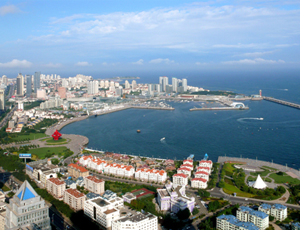Qingdao’s Blue Economy: Marine Investment on the Rise
 QINGDAO — China’s State Council recently approved the establishment of the Qingdao West Coast New Area in eastern Shandong Province, ushering in a “bluer” economy for the city of Qingdao. The blue economy, generally defined as the sum of ocean-related industries, is widely seen as the economic future of Qingdao. As such, it presents significant opportunities for foreign investment.
QINGDAO — China’s State Council recently approved the establishment of the Qingdao West Coast New Area in eastern Shandong Province, ushering in a “bluer” economy for the city of Qingdao. The blue economy, generally defined as the sum of ocean-related industries, is widely seen as the economic future of Qingdao. As such, it presents significant opportunities for foreign investment.
China is the world’s second-largest oil consumer, behind the United States. In 2013, growth in China’s oil consumption accounted for one-third of the equivalent global figure. This latest initiative in Qingdao indicates the importance given to the development of deep-sea oil sources by the Chinese government. Despite the abundance of marine resources in the country, China’s lack of supporting technology and professional personnel have greatly impaired the development of its blue economy.
The development of Qingdao’s blue economy can be traced back to 2011, when the State Council officially released plans to develop a “Blue Economic Zone” (BEZ) on the Shandong Peninsula—the nation’s first regional development strategy centered on the marine economy. Qingdao has several advantages that made it the ideal location for the heart of the Blue Economic Zone.
In 2013, Qingdao’s gross ocean product (GOP) exceeded RMB131.7 billion and grew at an annual rate of 18.2 percent, contributing more than 28.7 percent of the city’s GDP. At present, 30 percent of marine research institutions in the country are located in the city. After years of progress, Qingdao has taken a leading role in the ongoing development of China’s blue economy.
RELATED: China Releases 12th Five-Year Plan for the Marine Economy
Here we introduce two of the most popular investment areas in Qingdao.
Blue Silicon Valley
Blue Silicon Valley is a world-class research and development center for marine science and technology contained in a 576 km2 area situated to the north of Qingdao. More than 35 percent of the zone’s total population is involved in research, with more than 200 marine scientists from China and overseas conducting on-site research. In obvious reference to its U.S. namesake, Blue Silicon Valley is expected to be a driving force in the development of the city’s blue economy.
Currently, the zone’s developers are making efforts to attract foreign investment and talent, according preferential policies in terms of financial support and bank loans to scientific research centers established in the area. Construction will be completed by 2020.
Qingdao West Coast New Area
Located on the west coast of Jiaozhuo Bay between the Beijing-Tianjin-Hebei and Yangtze Delta regions, the Qingdao West Coast New Area covers 2,096 km2 of land and 5,000 km2 of sea. Serving as a strategic base for deep-sea and offshore exploration, the New Area is expected to become the leading economic hub of Shandong Province, equivalent to Pudong for Shanghai.
To date, five national-level industrial parks have been established in the New Area, including the Qingdao Tax-free Port and China-Germany Environmental Development Park. The New Area aims to be an international port and testing ground for various ocean-related economic initiatives.
By 2015, the New Area’s GDP is expected to reach RMB500 billion (US$78.7 billion), and upwards of RMB1 trillion by 2020. Foreign investment is highly encouraged in oil exploration, marine bio-pharmacy and marine equipment manufacturing.
Asia Briefing Ltd. is a subsidiary of Dezan Shira & Associates. Dezan Shira is a specialist foreign direct investment practice, providing corporate establishment, business advisory, tax advisory and compliance, accounting, payroll, due diligence and financial review services to multinationals investing in China, Hong Kong, India, Vietnam, Singapore and the rest of ASEAN. For further information, please email china@dezshira.com or visit www.dezshira.com.
Stay up to date with the latest business and investment trends in Asia by subscribing to our complimentary update service featuring news, commentary and regulatory insight.
Related Reading
 An Introduction to Development Zones Across Asia
An Introduction to Development Zones Across Asia
In this issue of Asia Briefing Magazine, we break down the various types of development zones available in China, India and Vietnam specifically, as well as their key characteristics and leading advantages. We then go on to provide a snapshot of the latest development zones across the rest of Asia. With several hundred development zones operating in the region, it is impossible to cover them all in the pages of just one publication. However, we hope that this issue will provide the basic fundamentals to understanding one of the most important business tools available to international businesses operating in Asia.
Marine Insurance & Legal Services Liberalization in the Shanghai Free Trade Zone
China’s VAT Reform and Its Impact on the Transportation Industry
- Previous Article Pingtan Implements Pilot Foreign Investment Reforms
- Next Article China Announces Film Industry Tax Incentives




























